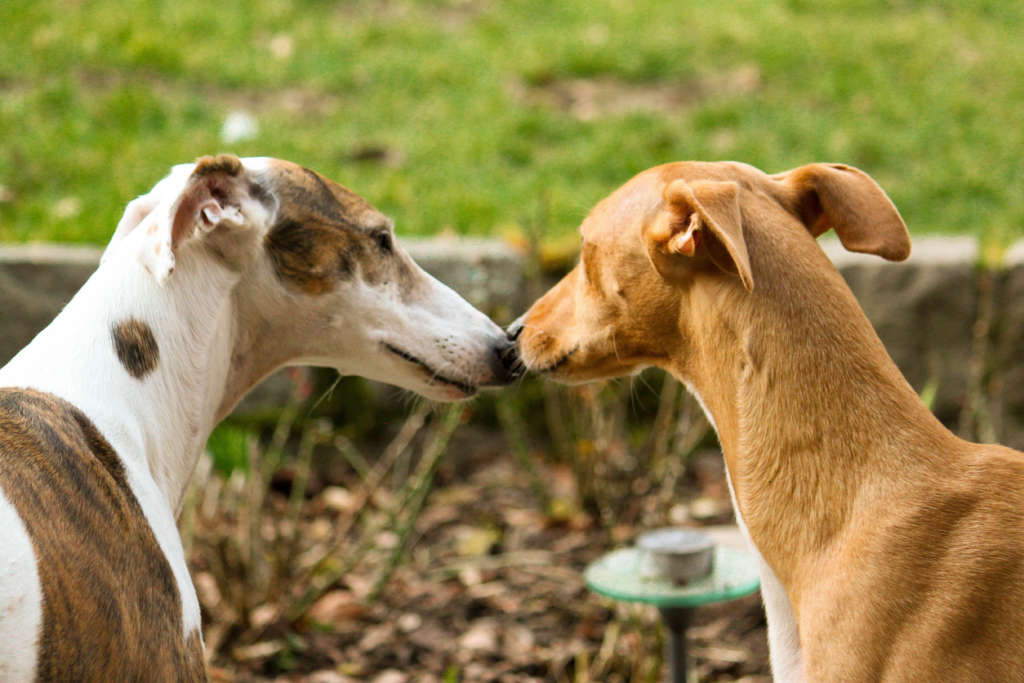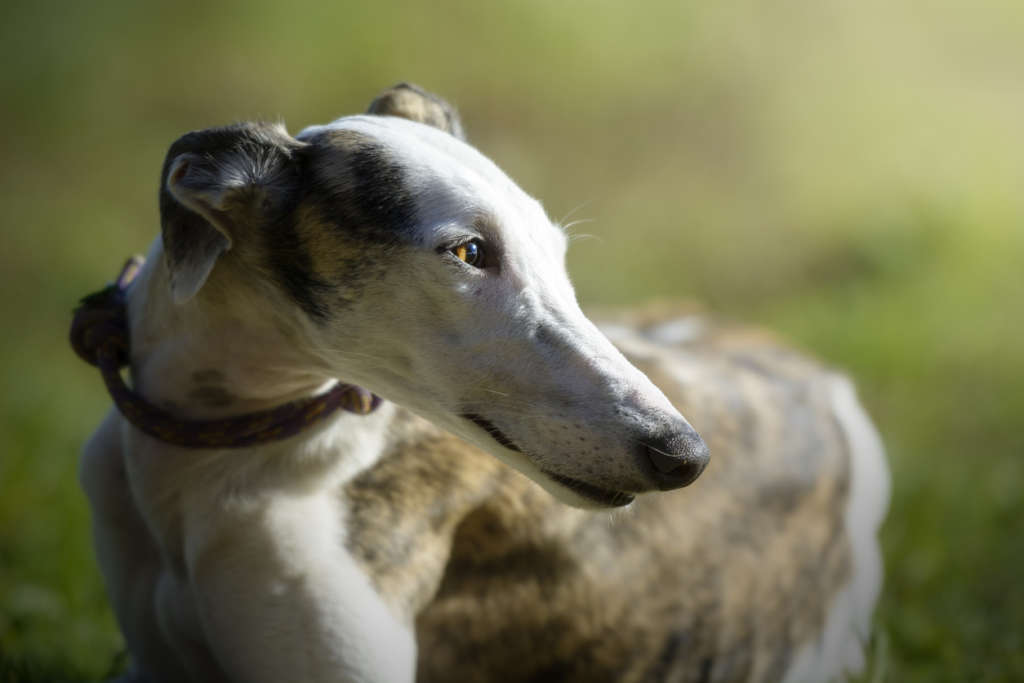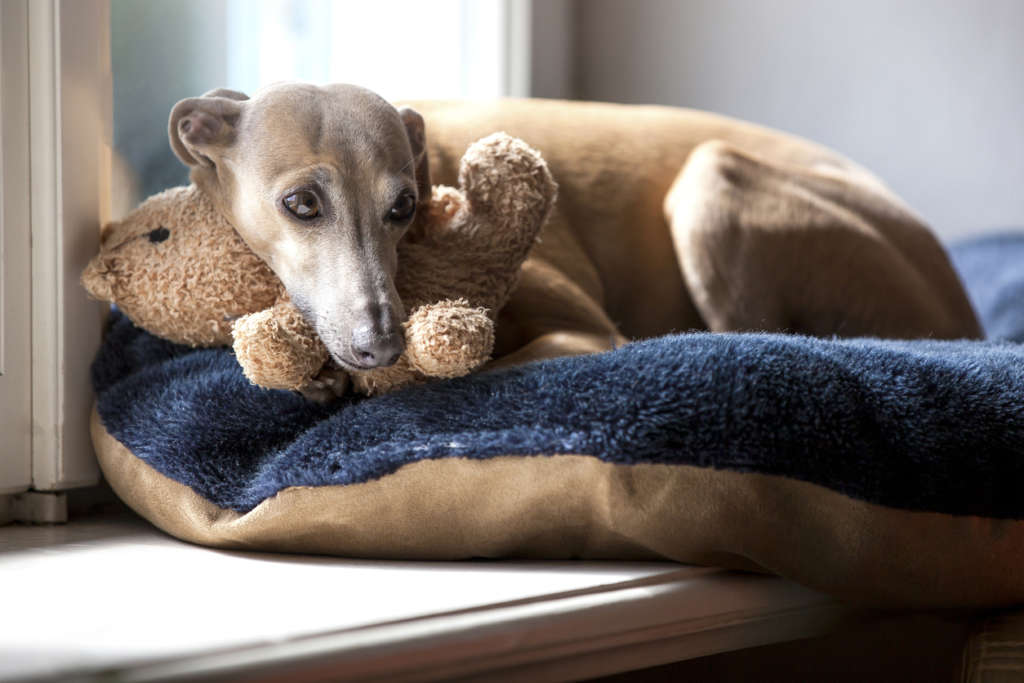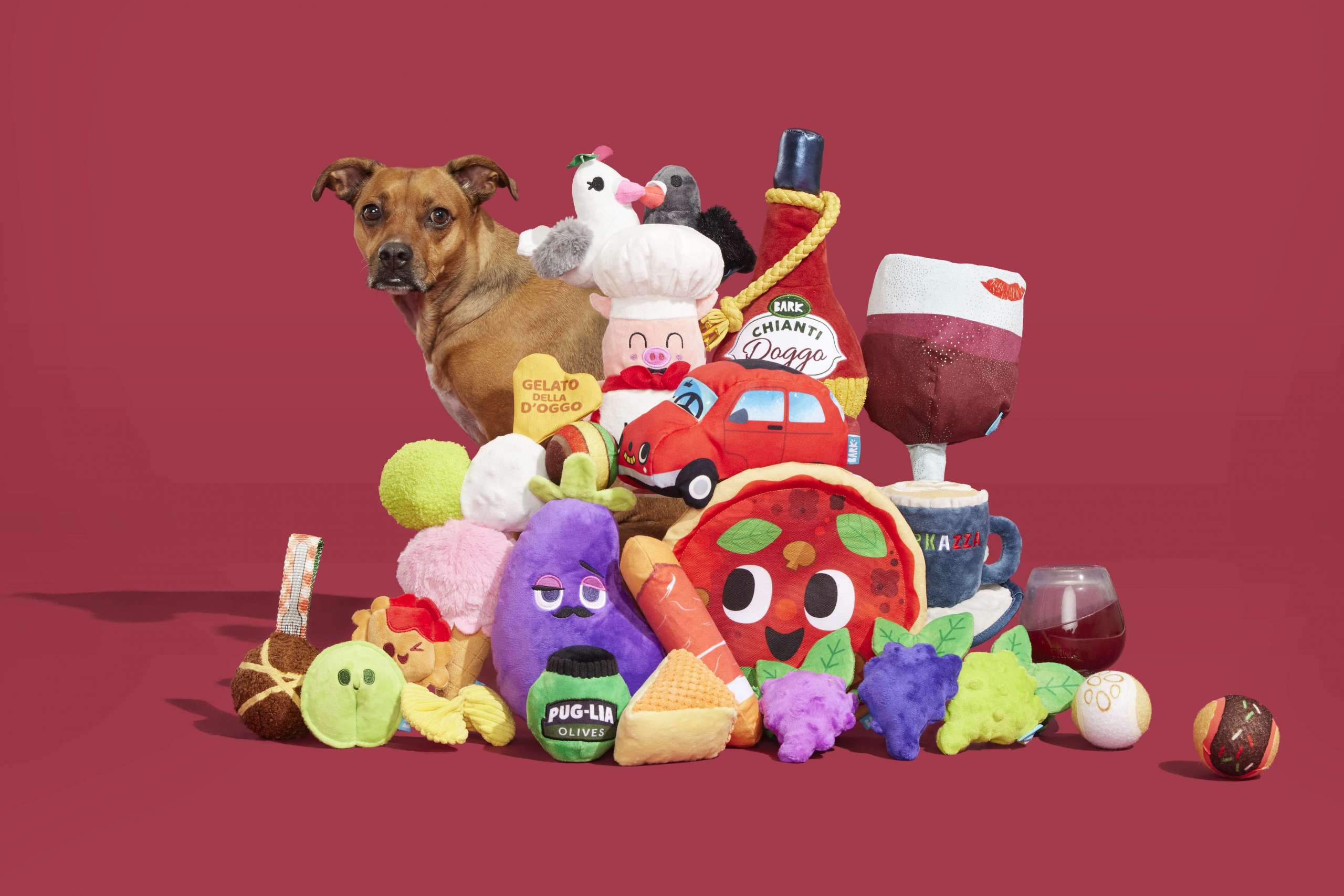Long, lean, and deeply emotional, greyhounds are a majestic breed. Greyhounds have a highly tapered and muscular body with pointed ears that fold downward. Other characteristics include big chests and narrow waists, making them unparalleled runners—at least for short distances. Interested in more than just high-speed chase scenes, this breed boasts an athletic physique as well as a wise and patient demeanor. Greyhounds are remarkably sweet, quiet, and kind animals, always looking for ways to please their favorite humans and eager for a calm, safe, and loving home.


Think that sounds like the perfect pooch for you? Discover how this breed went from champion sports dogs to fan-favorite companion dogs.
Breed Overview
Greyhounds Are Also Known As…
English greyhound. Sighthound, gazehound. Mick the Miller, speed racer, dish licker, “faster than the charter bus.”
What Is The History Of The Greyhound?
The greyhound breed type was revered in the ancient world. Their history may go back 8,000 years to an era of cave paintings. They were certainly admired by the ancient Egyptians, who filled their art, mythology, and writings with images and references to the greyhound. The ancient Egyptians even performed burial rituals for their most loved greyhounds—these dogs were even the companions of famous historical figures, including Alexander the Great and Cleopatra.
As the centuries passed, greyhounds became companions to people across Europe, most notably in Great Britain. Eventually, the Italian Greyhound and English Greyhound emerged as separate breeds. Sports like coursing were developed for canines, and greyhounds were among the first and most prized breeds to compete. Soon, greyhounds were crossing the plains of rural England and zig-zagging along the flatlands of the New World, chasing jackrabbits and other small rodents, all to the amusement of thousands of spectators. There were also breeders trying to breed the ideal racing Greyhound.
After making the trek to the United States, greyhound dog ownership expanded. Soon after, their claim to fame was made clear—they became domineering dogs in competitive racing.
At the time, greyhound racing was ubiquitous, but thanks to greater awareness of animal welfare, the sport has mostly disappeared. Everywhere across the country, former racing greyhounds are looking for forever homes. Today, these pups are eager to run into your arms and zoom around your backyard than zip down race tracks for entertainment.
How Big Do Greyhounds Get?
Greyhounds are certainly no small animal. You may be thinking of their cousin, the Italian greyhound, that stands at 13-15 inches tall and weighs 7-14 pounds. On the other hand, greyhounds share similar stature and poise, but are much bigger.
Height: 27–30 inches tall
Weight: 55–90 pounds
How Long Do Greyhounds (Generally) Live?
Greyhounds have surprisingly long lifespans for a breed their size, living 10 to 14 years on average.
What Is A Greyhound’s Temperament & Personality Like?
Despite their “off to the races” beginnings, greyhounds tend to prefer the quieter aspects of life. They’re positively content to sit in the sun on a calm day and listen to the birds sing, the radio play, or their favorite humans chat. Despite their athletic capacity, greyhounds are surprisingly lowkey, eager to sleep for 18 hours a day with breaks for snacks, exercise, and play.
From the moment you step into the room with a greyhound, you can tell this is one of the most gentle breeds to ever fetch a stick. They can be a little skittish around some strangers, but overall they have an easygoing grace and warmth.


Do Greyhounds Bark?
Almost never. Simply put, this is one of the quietest breeds around. While they have the capacity to bark and growl, most greyhounds prefer to remain silent. That said, particularly pampered greyhounds have been known to whine on occasion when things don’t go their way.
Are Greyhounds Good With Kids? Cats? Dogs?
The greyhound is excellent with children, along with the pug dog and Bernese mountain dog. Bring the whole family to hang with your hound. Greyhounds are tolerant and affectionate around children, so long as they’re treated well. Always encourage children to play safely and respectfully with animals, and if they can handle that, they’re likely to become fast friends with a greyhound, even one with no prior experience with kids.
Greyhounds were once bred to chase small animals, so be careful letting them play with your pint-sized pets. If you’re living with various four-legged friends, it’s best to introduce them to your new greyhound dogs slowly and individually while you’re supervising. Greyhounds can be sweet to cats and dogs, but they may feel threatened or afraid if they’re unaccustomed to other animals. Set your greyhound at ease with a few treats, some calming words, and plenty of affection to let them know you care.
Are Greyhounds High Energy?
Greyhounds are built for speed rather than distance. While this breed has the remarkable capacity for top speeds of up to 45 miles per hour, they’re not likely to keep that pace for long. Greyhounds are likely to run out of steam after a short period of all-out sprinting. To help them exert their energy safely, find wide-open spaces for speedy breakaways (just don’t expect to stay long). Greyhounds can blow through a day’s worth of energy in 15 minutes flat.
Are Greyhounds Hard To Train?
Few owners have had difficulty training a greyhound. These loyal canines were bred for easy obedience and can understand and execute commands after little instruction, as long as they were trained as a greyhound puppy.
They can be skittish if they’ve gone too long without a steady home, but what greyhounds (like most dog breeds) crave is affection and direction from their owner. They’re typically eager to please and looking for a task—that is, when they’re not full-on couch potatoes, just waking up from their last nap.


Do Greyhounds Have Health Issues?
Like all breeds, greyhounds have a handful of genetic predispositions to look out for. With consistent vet check-ups and preventative medicines, including vaccinations and parasite treatments, you’re likely to avoid most serious conditions, like parvo and rabies.
Out of all the greyhound health issues, dental problems are one of the most prevalent. Oral hygiene is an especially important practice for greyhounds. Incorporate teeth brushing into your weekly puppy routine to help your greyhound avoid gum disease and other oral health problems common to the breed. Aside from their pearly whites, you’ll want to pay attention to certain conditions greyhounds are prone to, such as:
- Joint problems, arthritis, and back problems
- Inflammatory bowel disease and bloat
- Health risks during anesthesia
- Obesity
- Dental disease
- Hair loss
- Von Willebrand’s Disease (similar to Goldendoodles)
Early detection is key to treating these conditions. Watch for early symptoms and consult with a vet as soon as possible.
Do Greyhounds Need To Be Groomed?
Despite having a short, manageable coat, greyhounds are regular shedders, blowing their coat twice a year and shedding seasonally as well. Plenty of vacuuming, doggy bed washing, air filtering, and brushing can help keep your home as hair-free as possible. A professional groomer can take it further with a semi-regular brushing, blowing, and bathing routine.
Greyhounds don’t need much, as far as grooming goes—just a nail clipping, a paw-pad trimming, and other minor maintenance to keep your dog in good spirits.
How Much Does It Cost To Care For A Greyhound?
Adopting a greyhound could be as inexpensive as $200 or several thousand, depending on where the dog is coming from, its age, and other characteristics. Additionally, you can expect to spend at least $200 a month taking care of your dog’s basic needs.


Food
Greyhounds have hefty appetites to match their powerful physique. Expect your pup to consume around two cups of kibble per day, averaging $40 to $80 per month in food costs.
Want to streamline your puppy’s meal prep? Check out BARK Eats for greyhounds. Enjoy the perfect meals for your pup, formulated by veterinary nutritionists and delivered straight to your door. This month, save 50%!
Routine Vet Care (Healthy Dog)
A standard vet appointment starts at $50 for a basic check-up. If you’d like to schedule additional testing, your vet should be able to provide you with a quote in advance and may offer various financing options. Bloodwork, x-rays, and various lab tests will all add to your total bill.
Preventative Medications for Greyhounds
Nearly all vets recommend monthly preventative treatment to protect your pup from heartworms. For around $100–300 per year, you can purchase medication that works against heartworms, fleas, and other parasites.
Greyhound Grooming
A low-maintenance dog like a greyhound doesn’t need much. You shouldn’t have to spend more than $70 on nail clippers, shampoo, a brush, and other simple basics.


Toys, Treats, Beds, & Accessories
Whether it squeaks, rattles, or is made out of rope, toys are key to your greyhound dog’s heart. Pick out toys that suit your pooch’s style, and consider investing in a doggy bed for the nights that you don’t want to share yours (however seldom that may be). Expect to spend $50 to $300 for the items and accessories you need to keep your dog happy.
Can’t decide how to spoil your favorite pooch? Let us help. A monthly BarkBox is jam-packed with toys, treats, and chews, and starts at only $23/month. Plus, you can upgrade to a Super Chewer box for the greyhound that tears through treats like nobody’s business. It comes with 2 fluff-free toys, 2 full-size bags of treats, and 2 meaty chews. There’s a lot to love with BarkBox, so order today and DOUBLE YOUR FIRST BOX FREE!
Finally, don’t forget to spoil your pooch (and yourself, from time to time) with a little TLC. Consider the following bonus expenses, including:
- Kenneling ($50–$150 per night)
- Dog walker ($15–$25 per visit)
- Puppy obedience classes ($200+)
- Unexpected costs, like emergency care ($500–1000+)
Sources:
Adopt A Greyhound Atlanta, Inc. History of the Breed.
http://greyhounds2.org/history-of-the-greyhound/
Highland Canine Training LLC. 15 Of The Fastest Dog Breeds In The World.
https://highlandcanine.com/the-fastest-dog-breeds-in-the-world/
Greyhound. Do Greyhounds Shed? (How to Conquer a Hairy Problem).
https://greyhoundhomecare.com/do-greyhounds-shed/
Central Texas Veterinary. Greyhounds.





